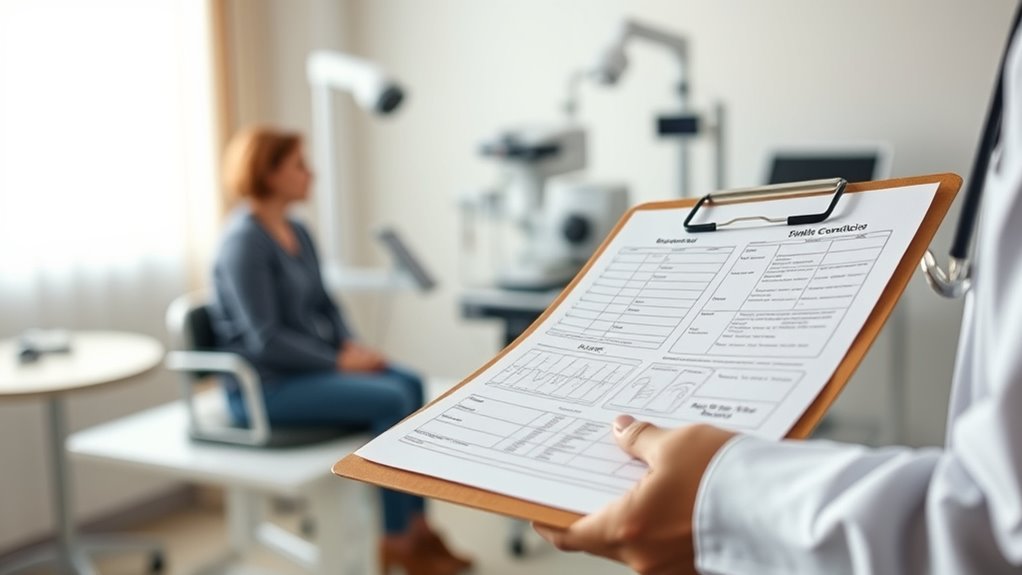To find out if you have BPD, a mental health professional will evaluate your persistent patterns of intense emotions, unstable relationships, and fluctuating self-image over time. They conduct thorough interviews, review your personal and medical history, and may gather insights from loved ones. Your symptoms should last at least a year and be consistent across different situations. If you want to understand how this process works in detail, keep exploring what’s involved.
Key Takeaways
- Diagnosis is based on clinical assessment of symptoms outlined in DSM-5 criteria, requiring at least five of nine specific features.
- Mental health professionals conduct interviews, questionnaires, and gather collateral information from loved ones.
- Duration and pattern of symptoms over at least one year help distinguish BPD from other mental health conditions.
- Differential diagnosis involves ruling out medical conditions and other disorders like bipolar disorder and PTSD.
- Thorough personal and medical history reviews ensure accurate diagnosis and appropriate treatment planning.
Recognizing the Symptoms That Signal BPD

Recognizing the symptoms that signal BPD can be challenging, but certain key signs often stand out. Mood swings are a hallmark, with intense reactions lasting hours to days. These rapid emotional shifts can make your feelings seem unpredictable and overwhelming. Individuals may also experience unstable self-image, which contributes to identity disturbances and difficulty in maintaining consistent self-perception. You might also experience recurrent self-harm or impulsive behaviors, which are clear indicators of BPD. Persistent feelings of emptiness, identity disturbances, and uncontrolled anger further signal the disorder. When these symptoms are present over at least a year, they support a diagnosis. The key is to notice patterns in your mood and behavior that repeatedly disrupt your life and relationships. Being aware of these symptoms helps you understand whether your emotional experiences align with BPD, prompting you to seek professional evaluation for an accurate diagnosis. Recognizing emotional dysregulation is crucial, as it often underpins many of the other symptoms associated with BPD. Additionally, understanding the relationship dynamics involved can provide further insight into the disorder’s impact on social interactions. Developing an understanding of the diagnostic criteria can also aid in distinguishing BPD from other mental health conditions. Moreover, recognizing financial aspects, such as impulsive spending or financial instability, can sometimes be associated with BPD-related behaviors.
Understanding the Diagnostic Criteria for BPD

Understanding how BPD is diagnosed begins with knowing the specific criteria mental health professionals use. The DSM-5 outlines nine symptoms, and you need at least five to meet the diagnostic criteria. These symptoms include fear of abandonment, unstable relationships, identity disturbance, impulsivity, and recurrent self-harm or suicidal behaviors. Additionally, some individuals may experience emotional instability that affects their daily functioning. This emotional fluctuation is often linked to underlying neurobiological factors that influence mood regulation. Importantly, the symptoms must be persistent and evident across different contexts, typically starting in early adulthood. Since there are no laboratory tests for BPD, a mental health professional relies on a thorough assessment to evaluate the presence and severity of these symptoms. This process guarantees that the diagnosis is based on observed behaviors and experiences, following current research and expert consensus to accurately identify the disorder.
The Role of Mental Health Professionals in Diagnosis

Mental health professionals play a crucial role in diagnosing BPD by conducting thorough assessments that examine the individual’s symptoms and history. They use a combination of interviews, questionnaires, and a review of personal and medical backgrounds to guide the diagnostic process. During assessment, they evaluate the presence, severity, and duration of specific symptoms outlined in DSM-5 criteria. To deepen understanding, professionals often gather collateral information from family or loved ones, providing a fuller picture of behaviors and patterns. This collaborative approach ensures an accurate diagnosis. The assessment process can be visualized as:
| Step | Tools Used | Purpose |
|---|---|---|
| Symptom review | Interviews, questionnaires | Identify symptoms |
| Medical history | Personal records | Rule out other conditions |
| Collateral info | Family/loved ones’ input | Confirm patterns |
| Differential diagnosis | Diagnostic criteria review | Ensure accurate diagnosis |
Additionally, understanding the diagnostic criteria thoroughly helps professionals differentiate BPD from other mental health conditions. Recognizing that symptom duration is essential for an accurate diagnosis, as some symptoms may fluctuate over time and require careful assessment. Furthermore, staying informed about current clinical guidelines is vital to ensure the most accurate and up-to-date diagnosis.
Conducting a Comprehensive Clinical Interview

Conducting a thorough clinical interview for BPD requires asking detailed questions about your current and past thoughts, feelings, behaviors, and relationship patterns. During the clinical interview, you’ll explore whether you meet the DSM-5 criteria, which include symptoms like impulsivity, fear of abandonment, and identity disturbance. The clinician will assess how long these behavioral patterns have persisted and their severity, typically requiring symptoms to last at least one year in adolescents. They may also involve family members or loved ones to gain additional insight into your behavioral patterns and history. Additionally, reviewing your medical and psychological history helps rule out other causes and identify co-occurring conditions that might influence the diagnosis. Understanding your self-awareness and emotional regulation skills can also provide valuable context for accurate diagnosis. Recognizing the operating hours of mental health services can help in planning timely intervention and support. Incorporating an understanding of asset division principles ensures a comprehensive approach to your overall well-being, especially if legal or financial issues are relevant to your situation. Moreover, evaluating your relationship patterns can shed light on recurring issues that may be linked to BPD symptoms. Gaining insight into your coping mechanisms can also help tailor effective treatment strategies. This extensive approach ensures an accurate understanding of your experiences.
Assessing Symptom Duration and Pattern

To accurately diagnose BPD, clinicians carefully evaluate whether your symptoms have been ongoing and recurrent over time. They look for a consistent pattern of symptoms that persist beyond isolated episodes. A thorough assessment often involves reviewing your history of symptom duration to ensure these issues have been present for at least one year for adolescents and longer for adults. This process helps distinguish BPD from other conditions by focusing on the long-term nature and recurring pattern of your symptoms.
Ruling Out Other Medical and Mental Health Conditions

When diagnosing BPD, you need to consider other medical and mental health conditions that might cause similar symptoms. Healthcare professionals carefully rule out issues like thyroid problems or neurological disorders, which can overlap with BPD features.
This process helps ensure an accurate diagnosis by distinguishing BPD from conditions such as bipolar disorder, PTSD, or depression.
Differential Diagnosis Challenges
Diagnosing borderline personality disorder (BPD) can be particularly challenging because its symptoms often mimic those of other mental health and medical conditions. Accurate diagnosis depends on careful differential diagnosis to distinguish BPD from similar disorders.
Co-occurring conditions, such as substance use or eating disorders, can mask or complicate BPD symptoms. To guarantee an accurate diagnosis, clinicians must evaluate:
- Whether mood swings are rapid and related to relationship dynamics or are mood episodes seen in bipolar disorder. Mood fluctuation patterns are essential in differentiating these conditions.
- If trauma-related symptoms indicate PTSD rather than BPD.
- The influence of physical health issues, like thyroid problems, that might produce similar symptoms.
- The presence of co-occurring conditions that could obscure or mimic core BPD features. Additionally, understanding symptom duration and context is vital for accurate differential diagnosis to avoid misclassification.
Understanding these challenges is key to avoiding misdiagnosis and providing appropriate treatment. Additionally, differential diagnosis involves careful assessment of symptom duration and context to ensure accurate identification of BPD versus other conditions.
Medical Condition Overlap
Because many medical and mental health conditions can produce symptoms similar to BPD, clinicians must carefully rule out these alternatives through thorough evaluations. This process involves a detailed differential diagnosis to distinguish BPD from other mental health conditions like bipolar disorder, depression, anxiety disorders, PTSD, dissociative disorders, or substance use. Additionally, understanding the symptom overlap among various conditions helps clinicians avoid misdiagnosis and ensures accurate treatment planning. Medical exams and lab tests are also essential to identify or exclude underlying medical issues such as thyroid problems or neurological conditions that can mimic BPD symptoms. By analyzing symptom patterns and medical history, mental health professionals determine whether symptoms stem from other mental health conditions or medical illnesses. Moreover, considering the impact of comorbidities can aid in developing a comprehensive treatment approach. This careful assessment ensures an accurate diagnosis, which is critical for developing an effective treatment plan tailored to your needs.
The Importance of Family and Personal History

A thorough understanding of a person’s family and personal history is essential in diagnosing BPD, as it reveals key genetic and environmental factors that contribute to the disorder. Your clinician will carefully examine your family history for mental health conditions like depression, anxiety, or other personality disorders, which can increase BPD risk.
They’ll also consider your personal history, especially childhood trauma, abuse, or neglect, which are significant indicators. A holistic review of your past behaviors, relationships, and emotional patterns helps differentiate BPD from other conditions.
This diagnostic assessment informs treatment planning and identifies potential co-occurring disorders. By understanding both your family and personal history, your mental health professional gains critical insights needed for an accurate diagnosis and effective care.
Challenges and Considerations in Diagnosing BPD

Diagnosing BPD can be tricky because symptoms often vary widely and can combine in many different ways.
You need to observe whether these symptoms persist for at least a year in teens and even longer in adults.
Since many signs overlap with other mental health issues, careful evaluation is essential to avoid misdiagnosis.
Symptom Pattern Variability
The wide variety of symptom combinations in BPD creates significant challenges in making an accurate diagnosis, as up to 256 different patterns can emerge. This symptom variability contributes to diagnostic complexity, making it hard to identify consistent features.
To accurately assess, mental health professionals look for stable, long-term patterns rather than transient or recent symptoms. Consider these points:
- Symptom variability can lead to overlapping features with other mental health conditions.
- Persistent symptoms over at least one year are key, especially in adolescents.
- Sudden or transient symptoms are less indicative of BPD.
- A thorough mental health assessment is essential to navigate this complexity.
Understanding these factors helps ensure a more accurate diagnosis, despite the challenges posed by symptom pattern variability.
Long-Term Symptom Requirement
Establishing a long-term pattern of symptoms is essential because transient or recent issues can mislead diagnosis. Clinicians look for persistent symptoms over at least one year in adolescents and longer in adults, aligning with the diagnostic criteria. This symptom persistence helps distinguish BPD from temporary emotional states or other mental health conditions. Variability of symptoms over time and across situations complicates diagnosis, requiring careful assessment of long-term patterns. Remember, at least five of the nine DSM-5 criteria must be present consistently to confirm BPD. Sudden or isolated symptoms are less indicative of BPD and may point elsewhere. The complexity of symptom combinations emphasizes the importance of evaluating long-term symptom patterns thoroughly.
| Symptom Pattern | Duration Needed | Diagnostic Focus |
|---|---|---|
| Long-term symptoms | ≥ 1 year | Symptom persistence |
| Variability | Over time | Accurate diagnosis |
| Symptom combinations | Up to 256 | Pattern recognition |
How a Formal Diagnosis Guides Treatment Planning

A formal diagnosis of borderline personality disorder (BPD) provides a clear foundation for developing an effective treatment plan. It helps guide your assessment and determines the most suitable therapy options.
Here’s how it shapes your treatment:
- It identifies the severity and subtype of BPD, allowing for tailored interventions.
- It confirms symptoms are persistent, ensuring accurate diagnosis and appropriate therapy.
- It rules out other conditions, so your treatment targets core symptoms effectively.
- It informs your mental health professional’s choice of therapy, such as dialectical behavior therapy (DBT) or mentalization-based treatment, customized to your needs.
This diagnosis acts as a roadmap, ensuring your treatment strategy addresses your specific challenges and promotes recovery.
Frequently Asked Questions
How Do Doctors Test for BPD?
You might wonder how doctors test for BPD. They don’t use blood tests or scans; instead, they conduct detailed interviews and assessments that look at your mood, behavior, and relationship patterns over time.
They use tools like questionnaires and involve family input.
What Happens to Untreated BPD?
If you leave BPD untreated, things can quickly spiral out of control. Your mood swings might become more intense, and relationships could become unstable, leading to isolation.
Without help, you’re at higher risk for self-harm, substance abuse, and even suicidal thoughts—dangerous and life-threatening.
Over time, these unmanaged symptoms can cause serious legal, social, and personal problems, making it harder to regain stability and find peace.
What Is the Average Age to Be Diagnosed With BPD?
You might wonder when people typically get diagnosed with BPD. Usually, it’s in early adulthood, around 18 to 25 years old. Symptoms often start during adolescence, but doctors wait at least a year to confirm the diagnosis.
Since emotional and personality development is still changing, diagnosis in children or very young teens is rare. Recognizing BPD early helps you get the right treatment sooner.
What Are the 4 Major Criteria Used to Diagnose BPD?
When you’re wondering about the major criteria for BPD, you should know that clinicians look for five out of nine specific symptoms.
The four major ones include intense fear of abandonment, unstable relationships, impulsive behaviors like reckless actions, and recurrent self-harm or suicidal thoughts.
Recognizing these signs helps professionals accurately diagnose BPD and differentiate it from other mental health conditions.
Conclusion
Understanding how BPD is diagnosed empowers you to seek clarity and support. Remember, diagnosis is like opening a complex puzzle—each piece revealing a clearer picture of your experiences. By trusting mental health professionals and openly sharing your history, you pave the way for effective treatment. Don’t forget, the journey toward understanding is a marathon, not a sprint—patience and persistence will light your path to healing and self-awareness.
Isla’s writings reflect a profound connection to the BPD community, offering solace and understanding to those who feel isolated by their struggles. Her articles explore the nuances of relationships, healing, and self-discovery, all through the lens of BPD. Isla’s compassionate approach to storytelling encourages readers to embrace their journey with hope and resilience.










